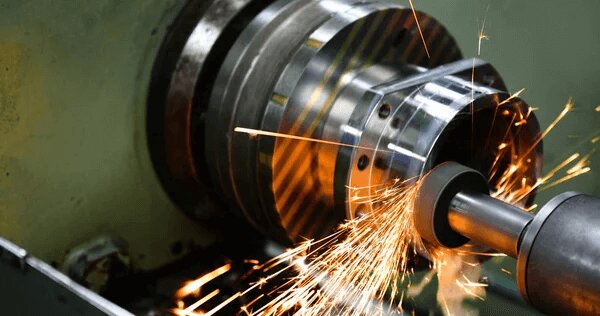10 Causes of Grinding Chatter Problem & Solutions
In the field of machining, grinding chatter is a key issue that has long plagued practitioners. The American Society of Mechanical Engineers (ASME) points out that grinding chatter not only reduces production efficiency but may also lead to a reject rate of up to 30%, seriously affecting the economic benefits of enterprises.
Its causes cover various aspects such as the grinding wheel, workpiece, grinding machine, and external environment. The main solutions include selecting the grinding wheel according to the workpiece characteristics and dressing it regularly, precisely calibrating the grinding machine, scientifically setting parameters based on material properties and working conditions, and stabilizing the machining environment through vibration isolation and temperature control measures.
Next, we will deeply analyze the causes of grinding chatter and propose effective solutions to improve the quality and efficiency of machining.

Ⅰ.Interaction between Grinding Wheel and Workpiece
Causes
The interaction between the grinding wheel and the workpiece is an extremely complex dynamic process. Research by the International Academy for Production Engineering (CIRP) shows that the micro - geometric shape and distribution of the grinding wheel grains significantly affect the cutting force during the grinding process. In addition, when the grinding wheel contacts the workpiece, due to the uneven shape of the grains, the contact area changes continuously, causing intermittent changes in the cutting force. The research findings in "Investigation of the Influence of Grinding Wheel Grain Geometry on Cutting Forces in Precision Grinding" published in the "Journal of Tribology" indicate that through experiments on a variety of grinding wheels with different grain sizes and abrasives, when the effective contact area of the grinding wheel changes by 10%, the cutting force fluctuation can increase by 20% - 30%.
Solutions
Optimize the selection of the grinding wheel according to the material characteristics of the workpiece. For example, for hard and brittle materials such as ceramics, a fine - grained grinding wheel with a vitrified bond can effectively ensure a stable cutting action. At the same time, regularly dressing the grinding wheel according to the standard process can significantly improve the uniformity of grain protrusion and reduce the fluctuation of the cutting force.
Ⅱ.Grinding Wheel Imbalance
Causes
An unbalanced grinding wheel generates a centrifugal force when rotating at high speed, which is an important cause of vibration in the grinding system. Even for a medium - sized grinding wheel, an imbalance of only 0.1 g/cm can produce a significant vibration level at high speeds. Grinding wheel imbalance usually stems from manufacturing deviations, uneven wear during use, or installation errors.
Solutions
Before using the grinding wheel, strict balance detection must be carried out. For conventional applications, a simple balance stand can be used for static balancing to accurately determine the heavy area of the grinding wheel, and small counterweights can be added or removed for correction. For high - precision grinding applications such as aerospace component grinding, a dynamic balancing machine is required, which can measure the imbalance of two planes simultaneously and provide accurate correction values.
Ⅲ.Grinding Wheel Wear or Damage
Causes
As the grinding wheel is continuously used, the cutting edges of the grains gradually become dull, which significantly increases the cutting force required to remove material from the workpiece. When the grinding wheel reaches about 10% - 15% of its designed material removal capacity, the cutting force can increase by up to 50% due to wear. In addition, if the grinding wheel has cracks or damage, it will cause a sudden large - amplitude vibration during the grinding process.
Solutions
Follow the recommendations of the European Federation of Abrasives Manufacturers (FEPA), and regularly conduct a comprehensive inspection of the grinding wheel to detect signs of wear and damage in a timely manner. Once wear is detected, the grinding wheel should be dressed in a timely manner to expose fresh grains and restore its cutting performance. If the grinding wheel is severely damaged, it must be replaced immediately. The dressing frequency should be scientifically determined based on the characteristics of the material being ground, grinding parameters, and real - time monitoring results of the workpiece surface quality.
Ⅳ.Improper Grinding Wheel Dressing
Causes
The correctness of the grinding wheel dressing process directly affects the distribution state and cutting performance of the grains. If the dressing tool is worn or the dressing parameters are set incorrectly, the surface of the grinding wheel will become rough or uneven. For example, using a dressing tool with an overly large diamond tip will create deep grooves on the surface of the grinding wheel, resulting in uneven cutting forces and seriously affecting the grinding quality.

Solutions
Use a well - maintained dressing tool with a suitable diamond size and shape. The dressing parameters, including dressing speed, feed rate, and cutting depth, must be precisely optimized according to the type of grinding wheel and the requirements of the grinding process. Generally, for resin - bonded grinding wheels, the dressing depth per pass is preferably controlled within 0.05 - 0.1 mm.
Ⅴ.Improper Workpiece Support
Causes
The support stability of the workpiece during the grinding process is crucial. When the workpiece is insufficiently supported or the support method is inappropriate, it is prone to deflection under the action of the grinding force, especially for long or thin workpieces with a large length - diameter ratio. For workpieces with a length - diameter ratio greater than 5, if the support is improper, the probability of chatter will increase significantly. For example, when grinding a slender shaft without effective support at both ends, the workpiece will deflect laterally, causing a significant fluctuation in the cutting force.
Solutions
Select appropriate workpiece clamping devices, such as centers, V - blocks, or chucks, to ensure stable support of the workpiece. For long workpieces, additional auxiliary supports, such as center rests, should be added. In actual operation, the support position and force should be precisely adjusted according to the material, size, and grinding process requirements of the workpiece to minimize workpiece deflection. For example, when grinding a long shaft, the contact pressure of the center rest should be controlled at 10 - 20 N to prevent excessive movement of the workpiece.
Ⅵ.Non - circular Workpiece or Loose Clamping
Causes
A non - circular workpiece (such as an elliptical one) will cause the cutting depth of the grinding wheel to change continuously during grinding, resulting in fluctuations in the cutting force and chatter. At the same time, if the workpiece is not firmly fixed in the clamping device, it will experience slight displacement during the grinding process, disrupting the stable cutting process. A workpiece with a roundness error exceeding 0.05 mm will produce obvious chatter during high - speed grinding.
Solutions
Before grinding, use high - precision measuring equipment, such as a coordinate measuring machine, to strictly detect the roundness of the workpiece. If shape errors are found, pre - processing should be carried out for correction. When clamping the workpiece, the clamping force should be reasonably determined according to the material characteristics and size of the workpiece. For medium - sized steel workpieces, a clamping force of 50 - 100 N can not only ensure the stability of the workpiece but also avoid workpiece deformation caused by excessive clamping.
Ⅶ.Improper Grinding Machine Setting or Calibration
Causes
The precise calibration of each component of the grinding machine is the key to ensuring the grinding quality. If there are deviations in the calibration of the spindle, worktable, and wheel head, it will lead to uneven cutting forces. For example, a perpendicularity deviation of only 0.1° between the spindle and the grinding worktable can increase the chatter amplitude by 15% - 20%, seriously affecting the grinding accuracy.
Solutions
Regularly use precision measuring tools, such as dial indicators and autocollimators, to comprehensively calibrate the components of the grinding machine. When calibrating the spindle, the run - out should be strictly controlled within 0.01 - 0.02 mm to ensure that the grinding machine is in the best working condition.
Ⅷ.Incorrect Grinding Parameters, such as Grinding Wheel Speed or Feed Rate
Causes
The grinding speed and feed rate have a decisive impact on the cutting force and the stability of the grinding process. Excessively high grinding speed will generate excessive heat on the workpiece, causing thermal damage, and the high - speed impact of the grains will intensify chatter. Excessively high feed rate will lead to excessive cutting force, disrupting the stability of the grinding process.
Solutions
Scientifically optimize the grinding parameters according to the workpiece material, grinding wheel characteristics, and the required surface finish. For quenched steel workpieces, the grinding speed is preferably controlled at 20 - 30 m/s, and the feed rate is set at 0.05 - 0.1 mm/rev. These parameters can be precisely adjusted through actual processing tests, combined with empirical data and professional processing manuals.
Ⅸ.Variations in the Material Being Ground, such as Changes in Composition or Hardness
Causes
Differences in the material properties of the workpiece can lead to inconsistent cutting behavior. In a batch of steel workpieces, slight differences in carbon content can result in different material hardnesses. Harder areas require greater cutting forces, thus triggering chatter.
Solutions
Before grinding, use advanced equipment such as a spectroanalyzer to comprehensively detect the material properties of the workpiece. Try to group workpieces with similar material properties for grinding. According to the detected material hardness, reasonably adjust the grinding parameters. For harder workpieces, appropriately reduce the feed rate and increase the grinding speed to maintain a stable cutting process.词
Ⅹ.External Factors, such as Temperature Changes or Vibration in the Surrounding Environment

Causes
Temperature changes can cause thermal expansion or contraction of the grinding machine components and the workpiece, affecting the calibration and clearances between components, and thus triggering chatter. Vibration from nearby machines or building structures transmitted to the grinding system can also disrupt the stable grinding process.
Solutions
Install the grinding machine in a workshop equipped with a constant - temperature and humidity control system to ensure a stable working environment. Use professional vibration - isolation equipment such as rubber - based vibration - isolation pads or air - spring vibration - isolation supports, which can reduce the transmission of external vibration by 30% - 50%. At the same time, regularly monitor the temperatures of the grinding machine and the workpiece, and adjust the processing parameters in a timely manner according to the temperature changes.
Summary
Grinding chatter is a complex issue involving multiple factors such as grinding wheels, workpieces, machine tools, and the environment. Continuously keeping an eye on the research progress of grinding chatter and constantly optimizing the grinding process are the keys to improving production efficiency and product quality. If you have any questions or are looking for a suitable grinding machine, you can continue to visit our official website. Minnuo will provide you with free consultation!

 Email
Email sales1:+1 213 865 6527
sales1:+1 213 865 6527 


